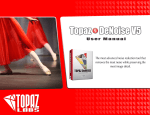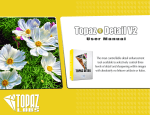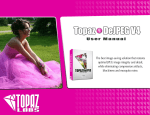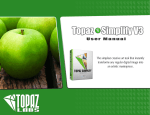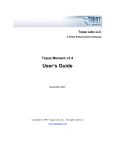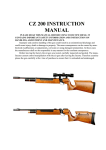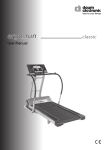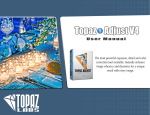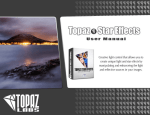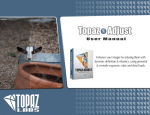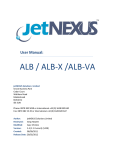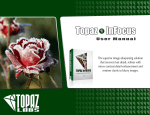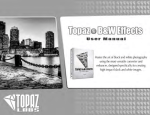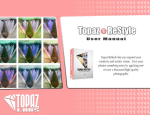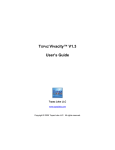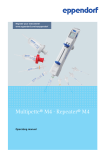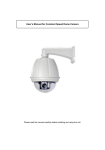Download User Manual - Topaz Labs
Transcript
Topaz DeJPEG v3.0 User Manual Topaz DeJPEG User Manual Contents I. Installation A. How to Install B. Entering Your Key C. Host-Specific Installation 1. Paint Shop Pro / Photo Impact 2. Irfanview 3 3 3 4 5 II. Introduction A. JPEG Artifacts 1. Causes of JPEG Artifacts? 2. Consquences of JPEG Artifacts? 3. DeJPEG vs DeNoise B. Topaz DeJPEG 1. About Topaz DeJPEG 2. New Features 6 6 6 6 6 6 8 III. Work Area A. Interface B. Preview C. Presets 1. Applying Presets 2. Refresh Preset Previews 3. Presets Menu 4. Deleting Presets 5. Sharing Presets 6. Importing / Exporting Presets D. Snapshots E. Preview Navigator 9 10 12 12 12 13 13 13 14 15 15 IV. Menu & Settings A. Menu 1. Preferences 2. Check for Updates 3. Enter Key 16 16 16 17 4. User’s Guide 5. Technical Support 6. Online Resources 7. About 8. Share (presets) 17 17 17 17 17 V. Settings & Parameters A. Main 1. Reduce Artifacts 2. Smooth Color 3. Sharpen 4. Sharpen Radius B. Advanced 1. Luma Noise 2. Color Noise 3. Color Edge Radius 4. Edge Threshold 5. Saturation 6. Add Grain C. Color Viewing Modes 1. Normal 2. Luma 3. Color D. Resetting Parameters 18 18 18 18 18 19 19 19 19 19 19 19 19 19 19 19 19 VI. Work Flow A. Sample Project 20 VII. Additional Resources A. Frequently Asked Questions B. Glossary C. Shortcut Keys D. Company Info 24 26 28 29 2 Topaz DeJPEG User Manual Installation Topaz DeJPEG is a Photoshop plug-in, which means that it won’t run by itself and requires a compatible host program. To Install 1. Close Photoshop or other image editing program if you are using it. 2. Open the Topaz DeJPEG zip file, double-click on the Topaz DeJPEG installer, and then follow the on-screen instructions. Mac Dmg Windows Zip 3. Your Topaz plug-ins will automatically be installed into your Photoshop plug-ins folder. 4. After the installation, you will need to enter your license or trial key. Important: To install the product on a second computer, you will need to download DeDPEG and then enter your same license key. Entering Your Key Entering your trial key allows you to save your projects and print them during your evaluation period. Entering your license key allows you to do the same, but without any time limitations. 1. Start by opening up an image in Photoshop. 2. Go to Filters -> Topaz Labs -> DeJPEG -> Menu... -> Enter Key... 3. You can then copy and paste or type your key in. Host-Specific Installation In Windows, Topaz DeJPEG is supported by most all host applications that support Photoshop plug-ins. This includes Photoshop Elements, Paint Shop Pro, Painter, and Irfanview, although there are other host programs that may also support it. Topaz DeJPEG is not supported by Google Picaso. To install DeJPEG in either Paint Shop Pro, Photo Impact, or Irfranview first download Topaz DeJPEG to the default location. Then, to install into each program, follow the host-specific instructions on the next page. 3 Topaz DeJPEG User Manual Installation How to install Topaz DeJPEG in Paintshop Pro / Photo Impact 1. First launch PaintShop Pro / Photo Impact. 2. Go to Menu file -> Preferences -> File Locations. Select “Plug-ins” from the “File Types” list and click “Add”. 4. Topaz DeJPEG is now available to use. Simply go to Effects -> Plugins and select “Topaz DeJPEG 3”. 3. Choose C:\Program Files\Topaz Labs\Topaz DeJPEG plug-ins and click “OK”. 4 Topaz DeJPEG User Manual How to install Topaz DeJPEG in Irfranview 1. Make sure that you have downloaded and installed the 8bf plug-in add-on, available on the Irfanview webpage. (http://www.software.com/ irfanview-plugin) Installation 3. In the screen that pops up, select “Add 8BF filters” and navigate to the C:\Program Files\Topaz Labs\Topaz DeJPEG\Plugins folder and click “OK”. You will then see “Topaz DeJPEG 3” in the Available/Loadable 8BF Filters section. 5 2. Open Irfanview and go to Image -> Effects -> Adobe 8BF filters. 4. To use Topaz DeJPEG in the future, simply go to Image -> Effects> Adobe 8BF filters again and select “Topaz DeJPEG 3”. Topaz DeJPEG User Manual Introduction JPEG Artifacts What Are JPEG Compression Artifacts? JPEG compression artifacts are random and unwanted problems caused by compressing an image. Most often, JPEG artifacts appear in photographs as blocks, dots, and fringes. They are also referred to as “checker-boarding” and “mosquito noise”. To see if your images have JPEG artifacts because of compression, zoom in on them and look for areas with checkerboard patterns, mosquito noise, fuzziness, reduced detail, reduced clarity, or uneven color. What Causes JPEG Compression Artifacts? JPEG compression artifacts are caused by the lossy compression that occurs when you save an image as a JPEG. JPEG images can be saved at different levels of compression. Using a higher compression produces a lower-quality image and smaller file size and using a lower compression produces a higher-quality image and larger file size. Consequences of JPEG Compression Artifacts JPEG compression is popular because it reduces file sizes and allows for increased storage, but 6 comes with some unwanted and typically irreversible side effects. It is a lossy form of compression, and as a result, image quality is lost and artifacts appear in the image. The quality that is lost from compression cannot be restored and will continue to diminish in quality every time you edit and save the JPEG. The presence of artifacts creates a visually unpleasant image with checkerboarding patterns, reduced image detail, and reduced clarity. Topaz DeJPEG User Manual Introduction Why can’t I Use a Noise Reduction Program to Remove JPEG Compression Artifacts? Generally, noise reduction algorithms are not effective at removing JPEG artifacts caused by lossy compression methods. Ph0toshop does provide a basic JPEG artifact remover. However, it is not as effective as Topaz DeJPEG, which specializes in reducing mosquito noise, discoloration, and fuzziness. Topaz DeJPEG 7 Before Topaz DeJPEG 3.0 About Topaz DeJPEG Topaz DeJPEG is a Photoshop plug-in that uses a recent breakthrough in image processing technology to eliminate the problems caused by JPEG image compression. It is the optimal way to fix JPEG compression artifacts. Most digital images are stored as JPEGs because they store high quality in a small file size. However, this convenience comes at a price: JPEG compression artifacts. If an image is highlycompressed, these JPEG artifacts, which may include mosquito noise, checkerboarding, and edge artifacts, become obvious and may affect the image quality. After Topaz DeJPEG 3.0 Topaz DeJPEG User Manual Topaz DeJPEG uses sophisticated algorithms that allow the user to quickly and effectively improve an image without spending a lot of time tweaking settings or making adjustment layers. It also includes several built-in presets that serve as starting points for many images. The primary functions of Topaz DeJPEG are: Topaz DeJPEG reduces lossy JPEG compression artifacts while retaining great image detail, offering you, the user, unprecedented control over the clarity of your photos. 2. Optimally remove JPEG artifacts like checkerboarding and mosquito noise. Lossy Compression Circle 1. Provide customers with the best quality in JPEG compression artifact reduction – period. Remove the most artifacts and keep the most detail possible in photos. 3. Clarify original image detail and preserve image integrity. 4. Fix fuzziness and image blur caused by JPEG compression. 5. Sharpen color edge, even for high-quality JPEG images. Lossless Compression Circle New DeJPEG Features Topaz DeJPEG 3.0 features the powerful noise reduction capabilities found in DeNoise and teams it up with faster processing time, incredible detail retention, and extensive smoothing and sharpening capabilities, as well as detail preservation, detail recovery, and multiple color noise views - allowing you to focus in on the precise type of noise that you want to correct. 8 Topaz DeJPEG User Manual Work Area Interface Although the Topaz DeJPEG interface may look intimidating at first glance, don’t worry: it’s actually quite simple and easy to use. You’ll be a pro after experimenting for a bit. In order to make sense of the function of each of the various controls, we have divided the interface into five sections: 2. Presets Provides “snapshots” of accessible pre-defined parameter settings 2 1 9 3. Menu Enables user settings and contains other options 4 4. Settings and Parameters Controls the editing using sliders to adjust the various effects 1. Preview Displays the processed preview of the image 5 3 5. Preview Navigator Allows for navigation of the image preview areas Topaz DeJPEG User Manual Work Area Preview Section The Preview section is the big image on the topright that shows you the processed preview of the image. To pan the preview image, click and hold the left mouse button on the preview image and drag it around. When you let go of the mouse button, the new portion of the image will be processed and displayed. 10 To compare the filtered and un-filtered images, click and hold the “View Original Image” button to switch to the unfiltered image. Letting go of the button will switch back to the filtered image. You can also use SPACE bar to switch back and forth between your filtered and unfiltered image in the preview window. Work Area Topaz DeJPEG User Manual 11 “Ctrl +” and “Ctrl –” keys zoom in and out of the image, just like in Photoshop. You can use the arrow keys to adjust the value of the slider that is currently selected. A complete list of the shortcut keys can be found in the Shortcut Keys section later in this manual. You can zoom in and out of the preview image by clicking the “+”, or “-” buttons below the preview image, and you can resize the window, as well. The “100%” button will zoom to 100% view. The zoom feature does not allow previews under 100%. Photoshop and other host software support many image modes, such as Grayscale, RGB, LAB, CMYK, etc. Images can also be 8, 16, or 32 bits per channel. Topaz DeJPEG supports both 8 bits per channel and 16 bits per channel. Topaz DeJPEG supports RGB mode only. To work on black-and-white images, first convert them to RGB mode. Topaz DeJPEG User Manual Presets Presets are a great way to speed up and simplify the whole process of using Topaz DeJPEG. Presets are set previews with previously defined settings that you can recall and reapply at any time. We’ve included some presets for you and, although they won’t work for every single photograph, they serve as excellent starting points for your own customized tweaking. Applying Presets Applying a previously defined preset is easy and intuitive. Simply clicking on a preset will change all the settings in Topaz DeJPEG to match those in the selected preset. To get the exact results you want, though, you may still want to go through the tabs and adjust the parameters. You can also view presets in List mode. “ Just click the Preset… button and select “Toggle list/Thumbnail’. The plug-in will also load more quickly since there are no thumbnails that need to be updated. Work Area Refresh Preset Previews Click the “Refresh” button to position the preview presets to where your main Topaz DeJPEG preview is located. If you navigate through the preview to a certain location within your image and then press the “Refresh” button, each preset preview thumbnail will be repositioned to display that section of image, and zoom in accordingly, as well. 12 Topaz DeJPEG User Manual Work Area The Presets Menu Sometimes, it’s convenient to be able to define presets and save your settings for later use. To do this, first adjust the Topaz DeJPEG parameters until you’re satisfied with the result. Then, click on the “Presets. . .” button and click “Save…”. Deleting Presets If you’d like to delete a preset, use the “Delete...” option with your desired preset selected. Enter a preset name and optional description and click “OK”. Note that if the name you’ve entered is the same as the name of a preset you’ve already defined, instead of creating a new preset, Topaz DeJPEG will just override the first one. Your preset will be automatically saved as a new file with a “.tpp” extension and will show up in the Topaz DeJPEG Presets menu, where its preview is immediately generated. To apply it later, just click it like you would any other preset. Please Note: Default presents cannot be overriden or deleted. Sharing Presets Feel free to share your saved presets by emailing them to your friends and having them put it into their Topaz DeJPEG Presets folder. Saved presets are located in the Topaz DeJPEG “Presets” folder: C:\Program Files\Topaz Labs\Topaz DeJPEG 3\Presets unless you’ve opted to install Topaz DeJPEG into a different directory. Mac users have this folder at HD/Library/ApplicationSupport/TopazLabs/DeJPEG3/Presets. 13 Topaz DeJPEG User Manual Importing and Exporting Presets To import a preset file, click the “Presets. . .” button, and then select “Import. . .”. Work Area To import a preset file directly from the Internet, click the “Import from Internet…” button and paste in the exact URL in which the preset file is located. 14 This will open up a “Browse” box to import a saved preset from your computer into Topaz DeJPEG. This is useful if you have downloaded a preset file that you’d like to use. To export the preset file to a certain location, click “Export”. You can then share this file with other users who may then import it. You can use the export feature to share your favorite DeJPEG presets with friends on Facebook Flickr, and Twitter. For more details see page 17. You can also follow Topaz Labs on : Facebook: http://www.facebook.com/pages/ Topaz-Labs/19955996369 Flickr: http://www.flickr.com/groups/topaz/ Twitter: www.twitter.com/topazlabs Topaz DeJPEG User Manual Work Area Snapshots New in Topaz DeJPEG v3.0 is the “Snapshots” feature. You’ll find it on the bottom left hand corner under the Presets panel. The “Snapshots” feature gives you a quick way to create up to two snapshots of your settings to compare without having to save presets. For example, if you wanted to compare how two different settings would look on an image, you could simply save both settings as different snapshots and compare the two without having to save, apply, and then delete presets. To use “Snapshots”, simply click “Snap 1” or “Snap 2” to save your current settings into memory. Clicking “Recall 1” or “Recall 2” applies the saved settings to the image in the same way a preset does. Please note that snapshots are deleted if you exit out of the current Topaz DeJPEG window because they are meant to help you in the current Topaz DeJPEG session only. 15 Preview Navigator The Preview Navigator allows you to see what region of the image you are viewing. You can also pan your image in the Preview section by “grabbing” the red box in the navigator and dragging it to the desired area of the image. Topaz DeJPEG User Manual Menu & Settings Menu You can access Topaz DeJPEG’s menu by clicking on the “Menu…” button in the bottom-right corner of the filter. “Enable pop-up help” gives reminders and tips when you hover your mouse over certain areas of the filter. Turn this off if you find that these pop-ups are impeding your work. “Pan preview faster” affects the panning speed of the Topaz DeJPEG preview. Every setting in the Preference window of Topaz DeJPEG is saved for future use. To change one of these preferences, simply access this menu again. Preferences Brings up a menu where you can change your pop-up help and pan settings. Check for Updates Select this to check if you have the most current version of DeJPEG. Topaz DeJPEG will let you know if there is a new version available. Please note that the “Disable multi-processor support” option only applies to Mac users. 16 Topaz DeJPEG User Manual Enter Key Select this to enter a license key or trial key for Topaz DeJPEG. Menu & Settings Share / Copy Settings to Clip Board Use this button to automatically generate forum or e-mail-friendly text of your current settings (copied to your clipboard). This can be useful for when you want to share your current settings but don’t want to deal with saving and exporting presets. 17 User’s Guide Select it to bring up this user manual. Technical Support Brings you to the Topaz Labs technical support page. Online Resources Brings you to the Topaz DeJPEG homepage to view video tutorials and suggestions. About Shows your current version of Topaz DeJPEG and lists the Topaz Labs homepage. Topaz DeJPEG User Manual Settings & Parameters Topaz DeJPEG has two settings tabs and a total of 10 parameters to help you achieve optimal image results. Main The Main tab contains the parameters: Suppress Noise, Recover Details, Clean, and Reduce Blur. Reduce Blockiness Smooth Color Sharpen Sharpen Radius Reduce Artifacts This is the main parameter in this filter. A higher value removes more JPEG artifacts but may soften the image. A good rule of thumb is to start small and work up to strike the perfect balance between artifact removal and edge integrity. Smooth Color This parameter smoothes out the color in the image. A higher value provides a smoother color, but you may lose detail if you make the value to high. Sharpen This parameter sharpens the image’s edges in order to compensate for some of the image softening caused by JPEG artifact removal. This parameter works in conjunction with the Sharpen Radius parameter. Sharpen Radius This changes the edge size of sharpening, which is measured in pixels. This value adjusts how large the edges to be sharpened are. Use a larger value for more blurred areas, and a smaller value for less blurred areas. For most users, “Reduce Artifacts” is the only feature you will need to use when editing images with minor JPEG artifacts. Be sure to not overuse it or you will lose edge sharpness. More advanced users may also want to make some adjustments in the Advanced tab. 18 Settings & Parameters Topaz DeJPEG User Manual Advanced The Advanced tab contains the parameters: Luma Noise, Color Noise, Color Edge Radius, Edge Threshold, Saturation and Add Grain. Luma Noise Clr Edge Radius Saturation Color Noise Edge Threshold Add Grain Saturation Increases saturation and evens out color to compensate for color loss due to artifact reduction. Add Grain Adds monochrome grain to the image in order to make it look more natural. Color Viewing Modes 19 Luma Noise Reduces noise in the luminance (“black-andwhite”) channel. Color Noise Reduces noise in the color channels. Color Edge Radius Increases the sharpness of the color edge. Use this to recall lost color detail. Edge Threshold Sets the threshold above which the color edge will be enhanced. Use it to change the strength of the edge definition. Normal Shows the regular image. Luma Shows the brightness in an image (the “black” and “white” or achromatic portion of the image). Color Shows the color components of the image. Resetting Parameters You can reset parameters to their default at any time using the “Reset” buttons. Work Flow Topaz DeJPEG User Manual Sample Project In this section we are going to walk you through a sample project step-by-step to help you become more familiar with the DeJPEG program. We will be using this photo for our example. You can notice the JPEG artifact reduction and detail enhancement in the “Before” and “After” shots left. In the following pages, we will show you how to achieve these optimal results with your own photos in just a few steps. Let’s get started! 1. Open an image file. 2. Create a duplicate layer of your image. Rightclick on your image layer in Layers and select “Duplicate Layer”. You can also achieve this by selecting your image layer and dragging it down to the “New Layer” icon. Before DeJPEG Enable the “Auto-Bright” feature to brighten the image for better viewing of artifacts in dark areas. After DeJPEG 20 Topaz DeJPEG User Manual 3. To begin working on your image, go to Filters ->Topaz Labs ->Topaz DeJPEG 3 4. Click on the preview and drag it around until you find an area that you like. If you want, you can go to “Preferences...” and check “Pan preview faster” to move the image around more quickly on the screen. Work Flow 6. You should be in the “Normal” color mode. Switch to the “Luma” color mode. This is the black-and-white color mode that enables you to see the image without color artifacts. 21 5. If you want to choose a default preset, scroll through the panel on the right side of the screen. To select it, double-click on it and the sliders will automatically adjust to the pre-defined settings and parameters. It is a good idea to start off in this mode and then progress to the “Color” mode in order to see the effects of your adjustments most clearly. Work Flow Topaz DeJPEG User Manual 7. In “Luma” mode, go to the “Reduce Blockiness”slider under the Main tab and adjust it to a level where you are satisfied. Since a higher value may soften the edges, it’s a good idea to start with a small value and slowly increase it. That way, you can be sure that you sufficiently remove artifacts while preserving edge integrity. Reduce Blockiness Smooth Color 9. Let’s work on color next. Switch to the “Color” mode. Sharpen 22 Sharpen Radius 8. Then move to “Sharpen.” If you find that you have lost some edge detail by reducing blockiness, you can move this slider up to recover it. Use it with “Sharpen Radius” to control edge harshness. Higher levels are good especially for blurred areas. Your image should now be free of JPEG artifacts. To modify any additional aspects of the image, proceed with the next steps. The best way to get great-looking images is to experiment with the filter until you’re satisfied. Despite the number of sliders and settings, getting a great result is easier than you might think! If you find that the color in your image is a little uneven, adjust the “Smooth Color” slider to clean these areas. 10. Then switch over to the Advanced tab. If you find that there is noise in your image, you can reduce it by using the “Luma Noise” and “Color Noise” sliders. First, switch back to Work Flow Topaz DeJPEG User Manual “Luma” mode and apply the “Luma Noise” adjustment. Then, return to “Color” and apply the “Color Noise” adjustment until you are satisfied. This will help clear up a noisy image. Luma Noise Clr Edge Radius Saturation Color Noise Edge Threshold Add Grain value of 0.05. 14. Switch back to the “Normal” mode and make any final adjustments that you need. When you are satisfied with your settings, click “OK” and Topaz DeJPEG will process your image. 23 11. Now, still in “Color” mode, you can improve color edge detail, by going to “Clr Edge Radius” and raising the value of that slider. Use it along with “Edge Threshold” to set the strength of the edge definition. 12. Color can also sometimes be weakened in the artifact reduction process. You can fix this by going to “Saturation” and raising the value of this slider to recover some color and balance out the saturation in the image. 13. Finally, you can add in some grain to make the final image look a little bit more natural with the “Add Grain” slider. This is set at a default Now you should have an artifact-free image! Please visit the Topaz DeJPEG website at http://www.topazlabs.com/dejpeg for video tutorials, and tips and tricks! Topaz DeJPEG User Manual Frequently Asked Questions “I need a Topaz DeJPEG trial key.” Visit http://www.topazlabs.com/downloads for a trial key. Please check your Spam folder, because Spam filters sometimes filter out the automated e-mail. If you need more time to evaluate, please e-mail us at [email protected] for an extended trial key. “I can’t find Topaz DeJPEG in the Photoshop Filters menu.” If you’re using Windows: 1. Go to C:\Program Files\Topaz Labs\Topaz DeJPEG 3\Plugins. Right-click the file “tldejpeg3.8bf” and click “Copy”. 2. Go to your Photoshop Plug-Ins folder, usually located at C:\Program Files\Adobe\Adobe Photoshop CSx\Plug-Ins. First, delete anything currently there that has to do with Topaz DeJPEG. This includes any folder that might be labeled “TopazDeJPEG” or any tldenoise3.8bf file. After doing that, right-click on any empty space and click “Paste”. 3. Quit and restart Photoshop and Topaz DeJPEG will appear in your Filters menu. You will have to open up an image to be able to use Topaz DeJPEG. If you’re using Mac: 1. Go to /Library/Application Support/Topaz Labs/ DeNoise 3/Plugins and right-click Topaz_dejpeg3.plugin. Click “Copy”. 2. Go to Applications/Adobe Photoshop CSx/ Plug-Ins (or wherever your Photoshop Plug-Ins folder is located). Delete any current Topaz DeJPEG files. Afterwards, right-click on any empty spot and paste the Topaz_dejpeg3.plugin file into the Photoshop Plug-Ins folder. 3. Quit and restart Photoshop and Topaz DeJPEG will appear in your Filters menu. You will have to open up an image to be able to use Topaz DeJPEG. “I can’t see the Topaz presets!” This is probably because your presets file is not readable. To check on Mac, go to “/Library/Application Support/Topaz Labs/DeJPEG 3” and right-click the folder called “Presets”. Make sure everyone has at least Read access to the folder. You’ll also need Write access if you want to save presets. You’ll also want to make sure that Topaz is installed in the default folder, or the presets will not show up or save. 24 Topaz DeJPEG User Manual Frequently Asked Questions “What are the limitations of the trial version of your software?” The only limit on the trial versions of the Topaz plug-ins is time. The free trial versions are designed to enable you to experience the full functionality of our plug-ins for a 30-day trial period. After the trial period is up, you will only be able to use the Topaz software by purchasing it. You will then receive a license key to activate the plug-in, and the trial version will automatically become the full version with no time limitations. “My Topaz DeJPEG 3 key doesn’t work!” There are a couple of reasons why Topaz DeJPEG might think your upgraded key is invalid. “If I use the 30-day trial version, will I need to uninstall the trial version before I upgrade to a full version?” Second, make sure that you have the latest version of Topaz DeJPEG. If you open Photoshop and go to Filters->Topaz Labs, the DeJPEG item should say Topaz DeJPEG 3 instead of just Topaz DeJPEG. If not, download and install the latest version of the software here: http://www.topazlabs.com/downloads. No, the Topaz trial software is designed to be unlocked to become the full version simply by entering a license key. The full license key will be e-mailed to you immediately after you purchase the software. “Where do I enter my key?” To enter your key, open up an image in Photoshop. Then go to Filters -> Topaz Labs -> DeJPEG3 -> Menu... -> Enter key... You can then copy & paste or type your key in. First, make sure that you actually have the upgraded key. It will be in the format “xxxxxxxxxxxx-xxxxxx-xxxxxx-xxxxxx” and will be all numbers in 30 digits in five groups of six (no letters). If you don’t have this upgraded key, visit http://www.topazlabs.com/dejpegkey.php to get it. Third, make sure that as you’re entering the key, there is nothing in the space beforehand. This means clicking, pressing “Ctrl-A”, and hitting “Delete” to make sure that absolutely nothing is in that field before you paste in the key. If it doesn’t work when you copy and paste, try typing it out, and vice versa. 25 Topaz DeJPEG User Manual Achromatic - Without color. Algorithm – Any bit of code or programming that defines a process. Auto-brightening – Temporary visual setting that brightens the preview image, allowing noise to become more visible. Brightness will not be permanently applied to image. Blur - Make or become unclear or less distinct. Clean Color – A parameter that controls the amount of color noise to reduce. Checkerboarding – A type of distortion that shows up as abnormally large pixel blocks in the image; tends to show up in areas with lots of information; usually only occurs with highly-compressed images. Chroma - Purity or intensity of color. CMYK – Cyan, magenta, yellow, and black. A color model commonly used for 4-color printing by printers to define and mix all of the colors they are capable of outputting. Glossary Compression Artifacts – Fuzziness or distortion in a compressed image or sequence of video images caused by lossy compression, i.e., into a JPEG format. Download – The process of transmitting or transferring data from one device to another. Edge Artifacts – The “ringing” artifacts or distortions found around image edges. Export – Outbound data transfer in a format that can be used by other programs. Grain –Lightly speckled noise that is used to apply a more natural look to an image. Image - An array of pixels that make up a digital picture. Image Compression - the application of data compression on digital images, most often into JPEG; can be lossy or lossless; lossy compression methods, especially when used at low-bit rates, introduce compression artifacts because data is lost. The most common form of image compression for photographs is JPEG. Color channel – The visual component of a color digital image that represents all the pixels in that picture made up of a specific primary color. For example, in a typical digital photo, the primary colors of red, green and blue (from the RGB color model) create all the colors in that photo, which may be represented by three color channels, each of red, green, or blue. Import – Inbound data transfer into a file or document. Color Noise – A type of digital noise in which color edges are blurred or the image is unevenly colored and filled with spots. Lossless Compression - A reversible way of reducing the size of data while preserving it. ISO – The amount of sensitivity of a digital camera sensor. A higher ISO enables faster shutter speeds and / or better performance in low light, but is more susceptible to experiencing increased noise. 26 Topaz DeJPEG User Manual Glossary Lossy Compression - An irreversible way of reducing the size of data by approximating it. it to a printer, or do any number of other manipulations or edits. Luma - The brightness in an image (the “black” and “white” or achromatic portion of the image). Luma represents the achromatic image without any color, while chroma components represent the color information. Plug-in - Computing (of a module or software) able to be added to a system to give extra features or functions. Noise – Visible effects of interference in an image from a digital camera, often appearing as random colored dots sprinkled throughout the image, or uneven coloration in what should be smoothly-colored areas. It is most likely to show up in the darker or shadowed areas of an image. Noise can be an undesirable effect that detracts from overall image quality or something you can choose to create artistically. Pan and zoom – A useful function that allows users to magnify the captured image in the preview and then, by using the cursor, to move or pan around the image. Typically “pan and zoom” allows users to magnify the image 2x or 4x. By magnifying the images and zeroing in on a specific section, you can see details not visible when the entire image is sized to fit the preview. Parameter - A numerical or other measurable factor forming one of a set that defines a system or sets the conditions of its operation. Photo-editing or Imaging software – Programs in which you can alter your photos and / or create digital images. Depending on the software, you can improve exposure, color, and other attributes of your picture, paint on it, add type, apply special effects, remove noise, resize it, combine it with other pictures, prepare it for e-mail or posting on the web, output Preset – A pre-defined combination of parameters and settings that are saved into a folder within Topaz DeNoise 3. Topaz provides default presets. Thumbnails of the presets are located on the panel at the left of the user interface. Preview - Shows the processed preview of the image. The Preview section is the big image on the top-right. It usually displays only a portion of the actual image. RAW image – An image file format that contains untouched, “raw” pixel information straight from the digital camera’s sensor. It has yet to translate the information in each pixel into the full color information, so this format offers more control over how the final JPEG or TIFF image is generated. Topaz DeNoise works best on RAW images. Reduce Blur – An de-blur function that uses de-convolution technology rather than simple sharpening techniques. RGB – Red, Green, Blue. The color model that is used in digital cameras and by computer monitors. Shadow - A dark area or shape produced by a body coming between rays of light and a surface. Smoothing - To make a surface more regular or consistent; free from perceptible projections, lumps, or indentations. 27 Shortcut Keys Topaz DeJPEG User Manual Topaz DeJPEG uses some shortcut keys to speed up your workflow. Many of these keys are similar to those in Photoshop. The following keys work at all times. Action View Original Image Recall Snapshot 1 Recall Snapshot 2 Capture Snapshot 1 Capture Snapshot 2 Reset Current Tab Reset All Zoom to Fit Zoom to 100% Zoom In Zoom Out MAC Shortcut Spacebar CMD-1 CMD-2 ALT-1 ALT-2 CMD-R CMD-ALT-R CMD-0CTRL-0 CMD-ALT-0 + or CMD - + - or CMD - - PC Shortcut Spacebar CTRL-1 CTRL-2 ALT-1 ALT-2 CTRL-R CTRL-ALT-R CTRL-0 CTRL-ALT-0 + or CTRL - + - or CTRL - - In addition, if a parameter slider is selected (usually by clicking on it) you can use the following keys to change its value: Left arrow or up arrow Right arrow or down arrow Page up key Page down key Home Key End Key Reduce value by 0.01 Increase value by 0.01 Reduce Value by 0.1 Increase value by 0.1 Set the value to minimum Set the falue to maximum 28 Topaz DeJPEG User Manual Contact Information Topaz Labs LLC 5001 Spring Valley Road Suite 400 East Dallas, TX 75244 Phone: 972.383.1588 Fax: 866. 876.1393 Technical Support http://topazlabs.com/support/ [email protected] For more information [email protected] Topaz Labs LLC, a privately owned company in Dallas, Texas, focuses on developing advanced video and image enhancement technology. With today’s widespread use of digital still cameras, digital video cameras, and HDTV, the need for high-quality digital images and videos has greatly increased. Topaz Labs’ mission is to bring practical state-of-the-art image and video enhancement technology to both professionals and consumers. Copyright © 2009 Topaz Labs, LLC. All rights reserved. http://www.topazlabs.com 29 User Manual Topaz DeJPEG Be sure to check out the complete line up of Topaz products. Image Plug-ins Ultimate control over image exposure, detail, and color gives you the power to make your photos pop. Advanced noise reduction filters noise while maximizing and retaining image detail simply and effortlessly. Takes any of your regular photos and effortlessly turn them into beautiful works of art. Specializes in creating crisp and stylized images. Also features extensive smoothing capabilities. Specializes in overall image improvement. Features sharpening, reconstructing, enlarging, highquality noise removal and JPEG artifact damage tools. Advanced JPEG artifact reduction filters eliminate JPEG compression artifacts while preserving image detail like never before. Video Plug-ins Easily and efficiently capture video frames and significantly increase their quality and resolution with this standalone Windows application. Increase video quality with this suite of video enhancement filters utilizing super-resolution technology. Go to http://www.topazlabs.com/downloads to get your 30-day free trial! 30































